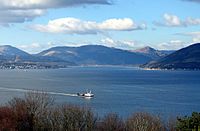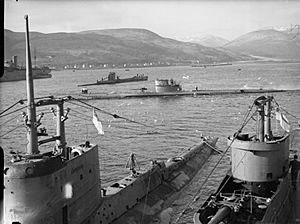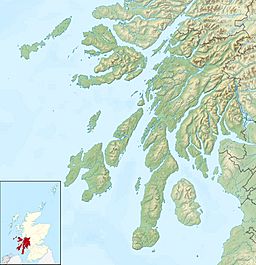Holy Loch facts for kids
Quick facts for kids Holy Loch |
|
|---|---|

The Holy Loch seen across the Firth of Clyde from Tower Hill, Gourock, with Hunters Quay on the left and Strone to the right
|
|
| Location | Cowal, Argyll and Bute, Scotland |
| Coordinates | 55°59′13″N 4°55′59″W / 55.987°N 4.933°W National |
| Type | Sea loch |
| Native name | An Loch Sianta/Seunta Error {{native name checker}}: parameter value is malformed (help) |
| Basin countries | Scotland, United Kingdom |
| Surface elevation | Sea level |
| Frozen | No |
| Islands | 0 |
The Holy Loch (Scottish Gaelic: An Loch Sianta/Seunta) is a sea loch, which is a type of sea inlet. It is located on the Cowal peninsula coast, part of the Firth of Clyde in Argyll and Bute, Scotland.
People believe the name "Holy Loch" comes from the 6th century. This was when Saint Munn arrived there after traveling from Ireland. Today, Kilmun Parish Church and Argyll Mausoleum is thought to be built where Saint Munn's original church once stood.
A famous company called Robertson's Yard was located at Sandbank, a village on the loch. They were well-known for building wooden boats in the late 1800s and early 1900s.
During World War II, the loch was used as a base for British Royal Navy submarines. Later, from 1961 to 1992, it became a base for United States Navy submarines that carried special missiles. In 1992, the US Navy base at Holy Loch closed because it was no longer needed after the end of the Cold War.
Contents
Geography of Holy Loch
The Holy Loch opens into the Firth of Clyde on its eastern side. This sea loch is about 1 mile (1.6 km) wide. It is also between 2 and 3 miles (3 and 5 km) long, though its length can change a little with the tide.
The town of Dunoon is located just south of the loch on the shores of the Clyde. Other villages like Kirn, Hunters Quay, Ardnadam, and Sandbank are found around the loch's shores. On the northern side, you'll find Kilmun and Strone.
In the past, many of these villages had piers where Clyde steamers would stop. Today, Western Ferries operates between Hunters Quay and McInroy's Point. Another ferry service, Argyll Ferries, connects Dunoon to Gourock. At the very end of the loch, a road leads past the Benmore Botanic Garden and Arboretum towards Loch Eck.
History of Holy Loch
Early History
On the shore of the Holy Loch, in a place called Kilmun, stands a church built in the 1800s. This church is on the site of much older churches. An ancient carved stone found there suggests a church might have been here as early as the 500s or 600s. The church is dedicated to Saint Munnu, an Irish saint who founded a church in Ireland.
You can still see parts of a 12th-century church at Kilmun. By the 1400s, Kilmun was a very important Christian center. This is why the nearby loch became known as the Holy Loch. The powerful Clan Campbell also chose it as their special spiritual home. From the 1300s, Dunoon Castle was controlled by the Campbell family. In the 1440s, Sir Duncan Campbell, the clan chief, lived near Kilmun.
Modern History
Robertson's Yard: Building Boats
Alexander Robertson began fixing boats in a small workshop in Sandbank in 1876. His company, Alexander Robertson and Sons Ltd (Yachtbuilders), grew to be one of the best wooden boat builders on the Clyde. Their most successful period was in the early 1900s. They started building famous racing yachts, including 12 and 15-meter designs.
Robertson's Yard built over 55 boats before World War I. They stayed busy even during the Great Depression in the 1930s. This was because many wealthy people loved yacht racing. During World War II, the yard focused on building boats for the British Navy. They made many fast motor boats for the war effort.
After the war, the yard built successful Loch Long boats. They also built two 12-meter yachts for the America's Cup race: Sceptre (1958) and Sovereign (1964). The Robertson family sold the yard in 1965. It then started making boats from fiberglass. Over its 104-year history, Robertson's Yard built 500 boats, and many are still sailing today! The yard stopped operating in the early 1980s. The site is now used for homes and the new Holy Loch Marina.
Holy Loch in World War II

During World War II, the Royal Navy used the Holy Loch as a base for its submarines. A special ship called HMS Forth served as a floating base for them. Royal Navy submarines often used the loch for training and practice during the war. Sadly, two submarines, HMS Vandal (P64) and HMS Untamed (P58), were lost in the Clyde due to accidents during exercises. Untamed was later brought back up from the water.
Near the Holy Loch, a large underwater barrier was built. It stretched between Dunoon and the Cloch Point Lighthouse. This barrier helped protect the waters from German U-boats (submarines).

From 1961 to 1992, the Holy Loch was a very important site for the United States Navy. It was called the "Fleet Ballistic Missile (FBM) Refit Site One." This was the home base for Submarine Squadron (SUBRON) 14. This squadron was part of the US Atlantic Fleet's submarine force.
The US military needed an overseas base to help its submarines that carried special missiles. This base would allow them to refuel and change crews. Discussions about this base began in 1959 between US President Dwight D. Eisenhower and British Prime Minister Harold Macmillan.
Holy Loch was chosen from several possible locations in the Firth of Clyde area. They looked for a sheltered place, close to an airport, with enough space for homes for Navy families. An agreement was reached in late 1960. The first support ship, USS Proteus (AS-19), was supposed to arrive in December. However, due to some disagreements in the British government and concerns from groups like the Campaign for Nuclear Disarmament (CND), its arrival was moved to March 3, 1961. Some protests did happen when the base opened.
Between 1961 and 1982, the shore facilities were managed by US Naval Activities London. In 1982, the Naval Support Activity (NAVSUPPACT) at Holy Loch became its own command. NAVSUPPACT managed many facilities and housing units for Navy personnel and their families.
A monument was built in Dunoon's Castle Gardens to remember the American Navy's time at Holy Loch.
Over the years, five different support ships (called submarine tenders) and one floating dry dock served at the loch. These ships helped repair and resupply the submarines.
| Arrived | Departed | Tender | Notes |
|---|---|---|---|
| March 1961 | January 1963 | USS Proteus (AS-19) | Began the first refit (repair and resupply) on March 6, 1961, for USS Patrick Henry (SSBN-599). |
| January 1963 | August 1966 | USS Hunley (AS-31) | |
| August 1966 | May 1970 | USS Simon Lake (AS-33) | |
| May 1970 | November 1975 | USS Canopus (AS-34) | |
| November 1975 | January 1982 | USS Holland (AS-32) | |
| January 1982 | June 1987 | USS Hunley (AS-31) | |
| June 1987 | March 1992 | USS Simon Lake (AS-33) |
| Arrived | Departed | Drydock | Notes |
|---|---|---|---|
| June 1961 | February 1992 | Los Alamos (AFDB-7) | In February 1964, it completed the first "off-center" docking of a Polaris submarine. |
Two notable events happened during the 30 years the US Navy was at Holy Loch. On November 29, 1970, a fire broke out on USS Canopus, and three crew members died. Almost four years later, on November 3, 1974, the nuclear submarine USS James Madison (SSBN-627) bumped into a Soviet submarine. This happened during a dive shortly after leaving Holy Loch. The American submarine was dented and had a nine-foot scratch. It spent a week at the base for checks and repairs.
Laurel Clark, who was an astronaut, worked at SUBRON 14 as a health officer. She was one of the astronauts who died in the Space Shuttle Columbia disaster in 2003.
New technologies and the end of the Cold War meant the base was no longer needed. The last support ship, the USS Simon Lake (AS-33), left Holy Loch in November 1991. The base officially closed the following June.



